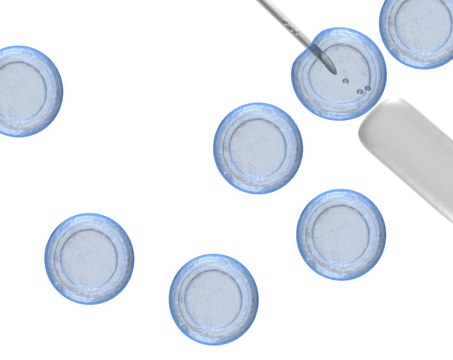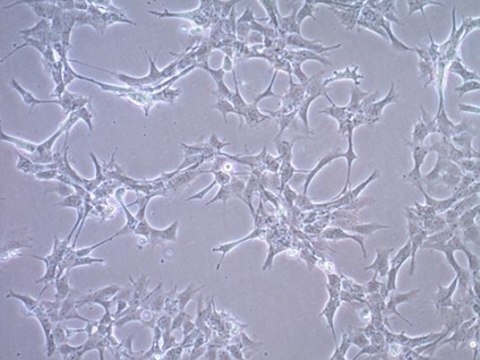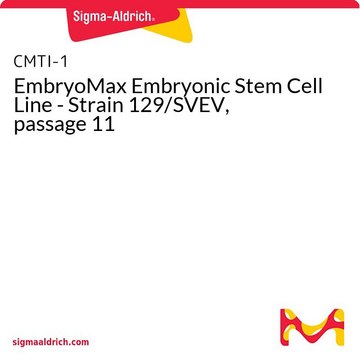SCR011
B6-White Murine ES Cell Line
The generation of gene-modified mice, created by homologous recombination in embryonic stem (ES) cells, has become a fundamental tool for analyzing gene function.
Sign Into View Organizational & Contract Pricing
All Photos(1)
About This Item
UNSPSC Code:
41106509
eCl@ss:
32011203
NACRES:
NA.81
Recommended Products
biological source
mouse
Quality Level
manufacturer/tradename
B6-White
technique(s)
cell culture | stem cell: suitable
input
sample type: mouse embryonic stem cell(s)
shipped in
liquid nitrogen
General description
The generation of gene-modified mice, created by homologous recombination in embryonic stem (ES) cells, has become a fundamental tool for analyzing gene function. The influence of genetic background on phenotype has been shown to be an important consideration in selection of a mouse model. Furthermore, the time required to achieve congenic status, which can be 18-24 months has further stimulated demand for targeting in pure inbred strains including C57BL/6 (B6) mice.
Millipore′s B6-White Murine ES cell line is the first commercially available C57BL/6 tyrc-2J albino line that allows for rapid coat-color determination of successful chimerism in the C57BL/6 mouse strain. When B6-White ES cells are injected into C57BL/6 blastocysts, chimeric mice are easily identified by their coat color (a mix of black and white patches), whilst non-chimeric littermates are black. These cells allow for the efficient generation of gene-targeted mice in a pure C57BL/6 genetic background, thus providing more experimental flexibility. Additionally the use of these cells can lower production costs by eliminating the need to maintain an albino blast donor colony, in order to assess chimerism by coat color when targeting in the C57BL/6 strain.
For germline transmission confirmation by coat color, it is recommended that male chimeras are mated with homozygous females of the B6-white strain (strain name: C57BL/6J-Tyrc-2J/J - available from Jackson Labs, stock number 000058).
STRAIN:C57BL/6-tyr(c-2J) albino mice
GENDER: Male
KARYOTYPE: 40XY
Millipore′s B6-White Murine ES cell line is the first commercially available C57BL/6 tyrc-2J albino line that allows for rapid coat-color determination of successful chimerism in the C57BL/6 mouse strain. When B6-White ES cells are injected into C57BL/6 blastocysts, chimeric mice are easily identified by their coat color (a mix of black and white patches), whilst non-chimeric littermates are black. These cells allow for the efficient generation of gene-targeted mice in a pure C57BL/6 genetic background, thus providing more experimental flexibility. Additionally the use of these cells can lower production costs by eliminating the need to maintain an albino blast donor colony, in order to assess chimerism by coat color when targeting in the C57BL/6 strain.
For germline transmission confirmation by coat color, it is recommended that male chimeras are mated with homozygous females of the B6-white strain (strain name: C57BL/6J-Tyrc-2J/J - available from Jackson Labs, stock number 000058).
STRAIN:C57BL/6-tyr(c-2J) albino mice
GENDER: Male
KARYOTYPE: 40XY
Cell Line Description
Embryonic Stem Cells
Application
Research Category
Stem Cell Research
Stem Cell Research
Physical form
Cells are supplied frozen in basal medium supplemented with 10% FCS and 10% DMSO
Storage and Stability
Place vials in the vapor phase of liquid nitrogen storage immediately upon receipt until it is convenient to proceed to subculture.
Disclaimer
Unless otherwise stated in our catalog or other company documentation accompanying the product(s), our products are intended for research use only and are not to be used for any other purpose, which includes but is not limited to, unauthorized commercial uses, in vitro diagnostic uses, ex vivo or in vivo therapeutic uses or any type of consumption or application to humans or animals.
Storage Class Code
10 - Combustible liquids
WGK
WGK 2
Certificates of Analysis (COA)
Search for Certificates of Analysis (COA) by entering the products Lot/Batch Number. Lot and Batch Numbers can be found on a product’s label following the words ‘Lot’ or ‘Batch’.
Already Own This Product?
Find documentation for the products that you have recently purchased in the Document Library.
Manipulation of mouse embryonic stem cells for knockout mouse production.
Limaye, et al.
Current Protocols in Cell Biology, Chapter 19, Unit 19-Unit 19 (2021)
Li Q Zhang et al.
Cell death & disease, 8(3), e2705-e2705 (2017-03-24)
Nicotinamide phosphoribosyltransferase (NAMPT) is a pleiotropic protein implicated in the pathogenesis of acute respiratory distress syndrome, aging, cancer, coronary heart diseases, diabetes, nonalcoholic fatty liver disease, obesity, rheumatoid arthritis, and sepsis. However, the underlying molecular mechanisms of NAMPT in these
Babita Madan et al.
Molecular and cellular biology, 29(11), 3186-3203 (2009-04-01)
Dppa4 (developmental pluripotency-associated 4) has been identified in several high-profile screens as a gene that is expressed exclusively in pluripotent cells. It encodes a nuclear protein with an SAP-like domain and appears to be associated preferentially with transcriptionally active chromatin.
Guangliang Bi et al.
FASEB journal : official publication of the Federation of American Societies for Experimental Biology, 32(7), 3583-3596 (2018-02-18)
Although a deficiency of surfactant protein B (SFTPB) has been associated with lung injury, SFTPB expression has not yet been linked with nicotinamide phosphoribosyltransferase (NAMPT), a potential biomarker of acute lung injury (ALI). The effects of Nampt in the pulmonary
Biswarathan Ramani et al.
Human molecular genetics, 24(5), 1211-1224 (2014-10-17)
Polyglutamine diseases, including spinocerebellar ataxia type 3 (SCA3), are caused by CAG repeat expansions that encode abnormally long glutamine repeats in the respective disease proteins. While the mechanisms underlying neurodegeneration remain uncertain, evidence supports a proteotoxic role for the mutant
Our team of scientists has experience in all areas of research including Life Science, Material Science, Chemical Synthesis, Chromatography, Analytical and many others.
Contact Technical Service


